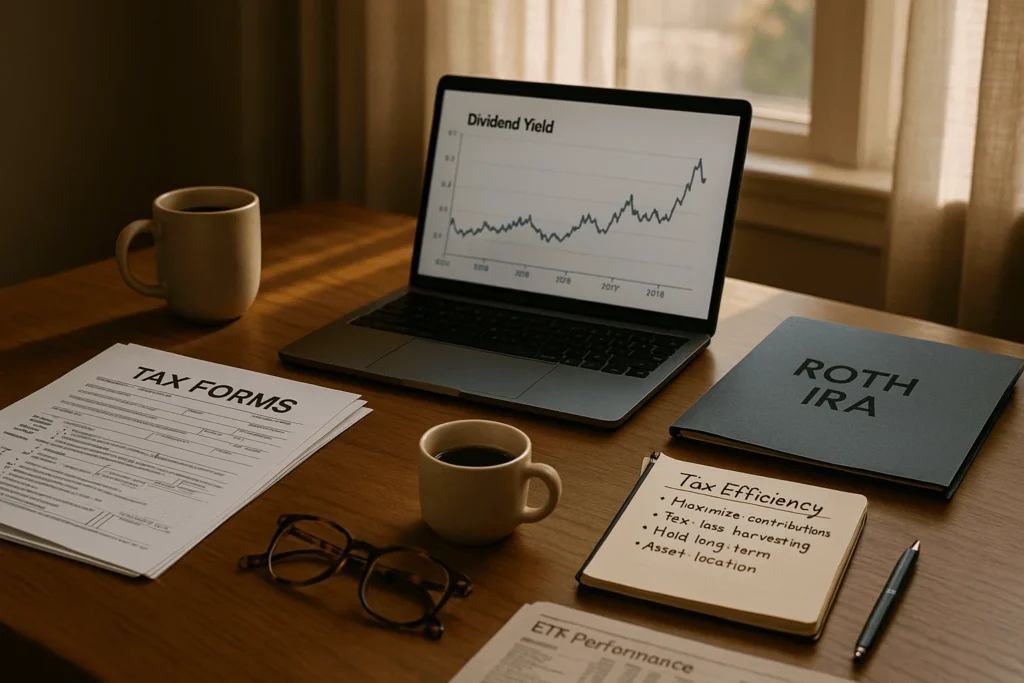SCHD is generally tax-efficient – especially if you know where to park it and how to play your cards.
Want to keep more of your dividends and less for Uncle Sam?
Here’s the direct answer: SCHD is built for investors who want their portfolio to work smarter, not harder. For a refresher on the fund’s structure and what’s inside, see the SCHD ETF overview.
Why Tax Efficiency Matters for Dividend Investors?
Taxes can quietly nibble away at your returns if you’re not paying attention.
Are you letting the tax tail wag the investment dog?
For dividend investors, tax efficiency means more cash stays in your pocket – rather than slipping through the cracks come April.
Think of tax efficiency as keeping more hay in your barn. The less you lose to taxes, the more you have to reinvest or spend.
SCHD Tax Profile – How Does It Compare?
So, how does SCHD stack up when it comes to taxes?
Most of SCHD’s dividends are “qualified,” meaning they’re taxed at a lower rate (typically 0–20%) instead of your ordinary income rate. That’s a win for most investors. SCHD’s focus on U.S. blue-chip stocks means fewer surprises at tax time – no foreign tax headaches, and most payouts get the favorable rate. If you want to see how sector allocation influences these outcomes, the sector allocation breakdown can help.
Here’s a quick look at how SCHD compares to other popular ETFs:
| Fund | % Qualified Dividends | Tax Efficiency (1–5) |
| SCHD | ~95% | 4.5 |
| VIG | ~97% | 4.7 |
| SPY | ~90% | 4.2 |
| SCHY | ~80% | 3.8 |
SCHD’s focus on U.S. blue-chip stocks means fewer surprises at tax time – no foreign tax headaches, and most payouts get the favorable rate.
Best Accounts for SCHD – Where Should You Hold It?
Where you stash your SCHD shares can make a world of difference. Should you put SCHD in a taxable account or tuck it away in an IRA?
If you hold SCHD in a Roth IRA, every dividend is yours to keep – tax-free. In a traditional IRA, you’ll defer taxes until withdrawal. In a taxable account, you’ll pay taxes on dividends each year, but most will be at the qualified rate. For retirees, these tax considerations for retirees can make a real difference in after-tax income.
Here’s a quick rundown:
- Roth IRA: Tax-free growth and withdrawals – ideal for SCHD.
- Traditional IRA/401(k): Tax-deferred, but withdrawals are taxed as income.
- Taxable Account: Pay taxes on dividends annually, but qualified dividends get a break.
Strategies for Minimizing Taxes
Want to keep more hay in your barn? Try these strategies:
- Prioritize holding SCHD in tax-advantaged accounts (Roth IRA first, then traditional IRA).
- If holding in a taxable account, take advantage of qualified dividend rates.
- Reinvest dividends to harness compounding – especially if you don’t need the income now.
- Be mindful of your holding period; sell too soon, and you might lose the qualified status.
Are you maximizing your after-tax returns, or just leaving money on the table?
Tax efficiency isn’t just a technical detail – it’s a big part of what makes SCHD a smart pick for dividend investors. By choosing the right account and understanding how your dividends are taxed, you’ll keep more of what you earn. Don’t let Uncle Sam eat your dividends; keep your barn well-stocked and your strategy sharp.

